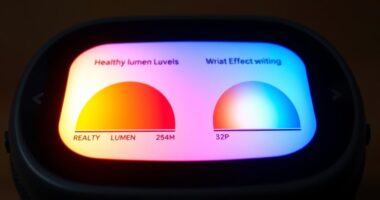Lux and lumens are different but related lighting metrics. Lumens measure the total light emitted by a source, while lux indicates how much light reaches a specific surface. Think of lumens as a flashlight’s brightness, and lux as how well your desk is lit. To avoid confusion, recognize that lumens help compare bulb brightness, while lux guides how well a space is illuminated. Keep exploring to better understand how these measurements affect your lighting choices.
Key Takeaways
- Lumens measure total light emitted; lux measures light intensity on a specific surface area.
- Higher lumens mean brighter sources; higher lux indicates more illumination on a target surface.
- Lumens are useful for comparing brightness of bulbs; lux guides appropriate lighting levels for spaces.
- Lumens focus on overall light output; lux considers distance, fixture placement, and area for effective illumination.
- Both metrics are essential for designing efficient, comfortable, and well-lit environments.
What Is Lumens and How Is It Measured?

Ever wonder how we measure a light’s brightness? It all comes down to lighting terminology like lumens, which is the measurement unit used to quantify luminous flux. Lumens indicate the total amount of visible light emitted by a source, regardless of direction. Unlike watts, which measure energy consumption, lumens focus on brightness. When you see a light bulb labeled with a lumen rating, it tells you how bright that bulb will appear. The higher the lumens, the brighter the light. This measurement helps you compare different lighting options objectively. Understanding lumens ensures you select the right light for your space, whether you need a cozy glow or bright illumination. Additionally, being aware of lighting technology advances can help you choose more energy-efficient and effective lighting solutions. So, lumens are essential to making informed lighting choices.
Understanding Lux and Its Role in Lighting Design

Understanding lux is essential for effective lighting design because it measures the amount of light reaching a specific surface. By knowing this, you can determine how well a space is illuminated and guarantee it’s suitable for its purpose. Lux helps you balance lighting color, creating the right ambiance and mood, whether you want warm, cool, or neutral tones. It also guides you toward energy efficiency by avoiding over-illumination, which wastes power and increases costs. When designing a space, consider how different lighting levels affect activity and comfort. Using lux measurements, you can select fixtures and placement that optimize light distribution without excess energy use. This approach results in a well-lit environment that’s visually appealing, functional, and cost-effective. Additionally, understanding light frequencies can enhance your ability to create specific healing or calming atmospheres through lighting choices.
Comparing Lumens and Lux: Key Differences

While lumens and lux are both measures related to light, they serve different purposes and are used in different contexts. Lumens measure the total amount of visible light emitted by a source, helping you understand its overall brightness. Lux, on the other hand, measures how much light lands on a specific surface, considering distance and area. This distinction affects lighting color and energy efficiency; a high-lumen bulb might be bright but wasteful if used in a large space, while lux ensures proper illumination where needed. Understanding these differences helps you select the right lighting for your needs, optimizing energy efficiency and achieving desired lighting color. Additionally, considering factors like light distribution is important for designing effective lighting setups. By comparing lumens and lux, you gain clarity on how each metric influences your lighting choices.
How to Calculate the Brightness of a Light Source

To calculate the brightness of a light source, you need to determine its luminous flux, measured in lumens, and understand how this light distributes over a given area. This involves evaluating the light’s intensity, which indicates how much light is emitted in a specific direction. Measurement techniques, such as using a light meter or photometer, help you gauge the light’s intensity accurately. First, identify the total lumens the source emits. Then, consider the area illuminated to understand how bright it appears. Brightness depends on how concentrated the light is over that space. By combining the luminous flux with measurement techniques for light intensity, you can precisely calculate how bright your light source appears in any setting. Additionally, understanding the light distribution pattern of the projector or lamp can help optimize brightness and image quality for your specific environment.
The Importance of Space and Distance in Lighting

The distance between your light source and the illuminated area considerably influences how bright that space appears. When you place fixtures closer to the surface, you’ll achieve higher ambient illumination, making the space feel brighter and more inviting. Conversely, increasing the distance reduces the light’s intensity, creating softer, more diffuse lighting. Proper fixture placement is essential; positioning lights too far away can diminish their effectiveness, while too close can cause glare or uneven illumination. If you want consistent brightness across a room, consider how space and distance impact lux levels. Adjusting fixture placement allows you to control the spread and intensity of light, ensuring your space is both functional and comfortable without wasting energy or creating harsh shadows. Additionally, understanding lighting metrics helps in selecting the right fixtures and placement strategies for optimal illumination.
Practical Examples of Using Lumens and Lux in Real Life

Understanding how lumens and lux work in real life can help you create better lighting for your home or workspace. For example, if you want a brighter, more vibrant space, choose bulbs with higher lumens, which provide more overall light. When setting up a reading nook or workspace, measuring lux guarantees the light is adequately focused and comfortable, reducing eye strain. Adjusting lighting color can enhance mood and productivity, so pick bulbs with appropriate color temperatures. Additionally, paying attention to energy efficiency helps you save money while maintaining adequate illumination. Using the right combination of lumens, lux, lighting color, and efficiency ensures your space is both well-lit and energy-smart, making your lighting setup practical and tailored to your needs. Recognizing the difference between these lighting metrics can help you make more informed choices for your lighting design.
Common Mistakes When Interpreting Lighting Metrics

Many people misinterpret lighting metrics because they focus on a single measurement without considering the context or how the metrics relate to each other. This often leads to confusion, especially when relying solely on lighting terminology like lumens or lux without understanding measurement accuracy. For example, assuming high lumens always mean bright lighting ignores how distance and surface area affect illumination levels. Similarly, misunderstanding the difference between luminance and illuminance causes mistakes in planning lighting setups. You might also overlook the importance of measurement accuracy, which varies with the tools used. To avoid these common mistakes, you need to interpret lighting metrics holistically, considering the specific environment, purpose, and how the measurements interact. This approach ensures more effective, accurate lighting decisions.
Choosing the Right Lighting for Different Settings

To choose the right lighting, you need to consider the specific brightness requirements of each space. Proper light placement can make a big difference in functionality and ambiance. By understanding these factors, you’ll ensure your lighting is both effective and comfortable. Additionally, exploring different lighting metrics can help you better compare options like lumens and lux to achieve the desired effect.
Setting-Specific Brightness Needs
Choosing the right lighting depends on the specific setting and how you’ll use the space. Different environments demand varying brightness levels to suit their purpose. For example, a cozy living room needs softer lighting with warmer lighting color, while a home office benefits from brighter, cooler light for focus. Consider energy efficiency when selecting fixtures, as more efficient options save money long-term. Here are key points to keep in mind:
- Adjust brightness based on activity, like reading or relaxing
- Use warmer lighting color for ambiance and comfort
- Increase brightness for detailed tasks and workspaces
- Opt for energy-efficient bulbs to save on electricity
- Match lighting levels to the room’s purpose for ideal comfort
- Incorporating farmhouse-style lighting fixtures can enhance the overall aesthetic and create a cozy atmosphere in your space.
Tailoring your lighting ensures comfort, functionality, and energy savings.
Optimal Light Placement
Proper placement of lighting fixtures enhances both the functionality and ambiance of any space. To achieve this, consider fixture placement carefully—position lights where they’re most needed without creating glare or shadows. Think about the purpose of each area: task lighting should be directed where you work, while ambient lighting provides a soft glow. The light color also plays a role; warmer tones create cozy atmospheres, while cooler shades promote alertness. When installing fixtures, place them at appropriate heights and angles to maximize coverage and minimize uneven lighting. Avoid cluttering ceilings or walls with excessive fixtures, which can disrupt the room’s flow. Additionally, be aware of regional bank hours to ensure your lighting needs align with your banking schedule. By thoughtfully selecting fixture placement and considering light color, you guarantee your space is both functional and inviting.
Tips for Making Informed Lighting Choices

To make better lighting choices, you need to understand the basics of how light works. Comparing measurements like lumens and lux helps you evaluate options effectively. By matching your specific needs to these metrics, you can select lighting that truly fits your space and activities. Additionally, understanding AI’s role in various sectors can inform smarter lighting solutions that optimize energy use and safety.
Understand Lighting Basics
Understanding the basics of lighting is essential for making informed choices that suit your space. Knowing how light color impacts mood and functionality helps you select the right bulbs, while considering energy efficiency can save you money long-term. Brightness isn’t just about lumens; it also involves how light feels in your environment. Here are key tips:
- Pick the right light color for your space and activity
- Balance brightness with comfort to avoid glare
- Opt for energy-efficient bulbs to reduce costs
- Understand how lumens measure brightness
- Use dimmers to control light levels and save energy
Being aware of these fundamentals guarantees your lighting meets your needs without wasting energy, creating a comfortable and functional environment.
Compare Light Measurements
How do you compare different light measurements to choose the best lighting for your space? Start by understanding that lux measures illuminance, while lumens indicate total light output. To make an informed decision, consider both metrics alongside lighting color, which affects mood and visibility. For example, a high lumen count with a warmer lighting color can create a cozy atmosphere, but might not be the most energy-efficient choice. Conversely, a lower lumen output with a cooler light can save energy without sacrificing brightness if positioned correctly. Always check the energy efficiency of bulbs, as some light measurements can be misleading without considering power consumption. Comparing these measurements helps you select lighting that’s not only effective but also cost-efficient and suited to your needs.
Match Needs to Metrics
Choosing the right lighting depends on matching your specific needs with the appropriate metrics. Understanding lighting terminology and measurement standards helps you select the right fixtures, whether you need focused brightness or even illumination. To make informed choices, consider:
- The purpose of the space (task vs. ambient lighting)
- The required brightness level (lumens vs. lux)
- The size and shape of the area
- The type of activity performed there
- How measurement standards influence light distribution
Frequently Asked Questions
How Do Lumens and Lux Impact Energy Consumption?
Lumens and lux directly influence your lighting’s energy efficiency and design. Higher lumens mean brighter light, but using more energy. Lux measures how well a space is illuminated, guiding you to optimize lighting for efficiency. By understanding these metrics, you can choose fixtures that provide adequate brightness without wasting energy. Good lighting design balances brightness and energy use, helping you save costs while maintaining a comfortable, well-lit environment.
Can Two Lights With the Same Lumens Produce Different Brightness?
Yes, two lights with the same lumens can appear differently bright due to factors like light uniformity and glare reduction. One fixture might distribute light more evenly, creating a consistent brightness, while the other could produce hotspots or uneven illumination. This affects how bright the space feels, even if the lumen output is identical. So, consider these aspects to guarantee you get the desired brightness and avoid harsh glare or uneven lighting.
Is Higher Lux Always Better for Task Lighting?
Higher lux isn’t always better for task lighting. You need to consider glare reduction and fixture placement to avoid discomfort and shadows. Properly positioned fixtures can improve brightness where you need it most without causing eye strain. Focus on balancing lux levels with even light distribution, ensuring your workspace is well-lit but not overly harsh. Remember, ideal lighting depends on the task and environment, not just higher lux numbers.
How Does Color Temperature Affect Perceived Brightness?
Color temperature markedly impacts your perception of brightness, influencing how visually comfortable you feel. Cooler temperatures (around 5000K) can make a space seem brighter and more alert, while warmer tones (2700K) offer a softer, cozy feel. Your perception of brightness varies with color temperature, affecting visual comfort. So, choosing the right color temperature aligns with your lighting needs and enhances overall ambiance without necessarily increasing actual brightness.
Are There International Standards for Measuring Lumens and Lux?
You might wonder if there are international standards for measuring lumens and lux. The answer is yes; organizations like the International Commission on Illumination (CIE) establish standards to guarantee measurement consistency worldwide. These standards help manufacturers and consumers compare lighting products accurately. Following international guidelines ensures that lumens and lux are measured reliably, making it easier to choose the right lighting based on consistent, standardized data regardless of where you are.
Conclusion
Remember, understanding lumens and lux is like mastering the language of light. Think of lumens as the volume of a song—brightening a room with a steady beat—while lux measures how intensely that music fills the space. By grasping these metrics, you’re the conductor of your lighting symphony. So, don’t let confusion cast shadows—shine a clear light on your choices and illuminate your space with confidence.









